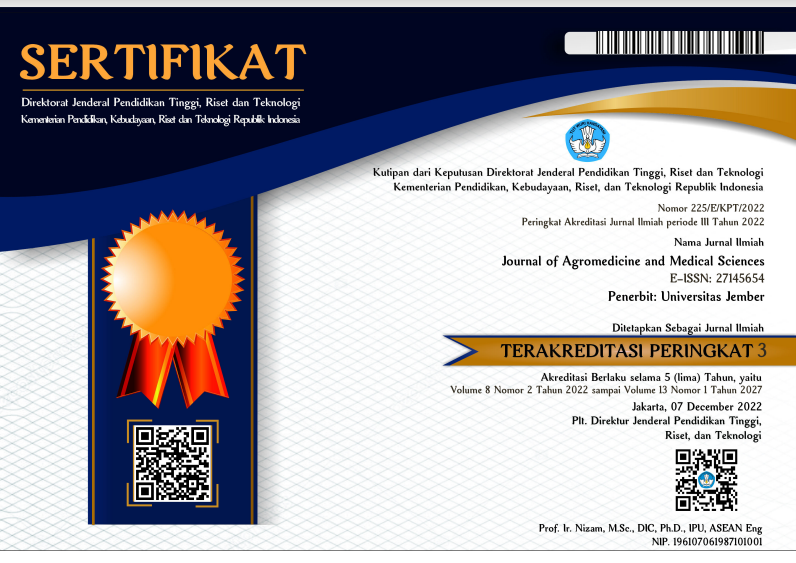Analysis of Health Literacy Index Difference Amongst Generation in Jagapura Primary Healthcare Work Area
DOI:
https://doi.org/10.19184/ams.v9i1.33929Abstract
Health literacy is one of the factors which has a big contribution to a person's health status. The rapidity of technology growth eases access to health information, this situation has to be balanced with good health literacy index. Several factors as generation, occupation, and education influence health literacy index. Many measuring tools have been developed to assess the health literacy index. Researcher uses the latest health literacy survey questionnaire in Indonesia, namely HLS-EU-SQ10-IDN which contains 10 questions. This type of research is analytic observational. The research was conducted in the work area of ​​the Jagapura Primary Health Care, Gegesik District, Cirebon Regency, West Java. A total of 146 people that spread over five village is taken as samples with purposive sampling method. The results of Chi Square analysis is the association between generation and health literacy index showed insignificant results with p = 0.705. For the correlation with work, the results are also insignificant with p = 0.296. Meanwhile, education level is associated significantly with p = 0.018. The data obtained indicate that there is no significant correlation between generational differences and the health literacy index. Older generation with higher educational background tends to have better health literacy index. On the other hand, the researcher concludes that government need a strategy to increase the quantity and quality of education in Indonesia as an endeavour to increase health literacy index in our society.
Keywords: health literacy index, generation, education, occupation
Downloads
References
Arslan, E., Çankırı, G., Üniversitesi, K., & Çelik, S. (2016). Generations and Their Relations in Social Processes. https://www.researchgate.net/publication/333918242
Central Bureau of Statistics. (2021). Berita Resmi Statistik. Bps.Go.Id, 7, 1–52. https://papua.bps.go.id/pressrelease/2018/05/07/336/indeks-pembangunan-manusia-provinsi-papua-tahun-2017.html.
Chesser, A. K., Keene Woods, N., Smothers, K., & Rogers, N. (2016). Health Literacy and Older Adults: A Systematic Review. Gerontology and Geriatric Medicine. doi: https://doi.org/10.1177/2333721416630492
Duong, T. V., Aringazina, A., Baisunova, G., Nurjanah, Pham, T. V., Pham, K. M., Truong, T. Q., Nguyen, K. T., Oo, W. M., Mohamad, E., Su, T. T., Huang, H. L., Sørensen, K., Pelikan, J. M., Van den Broucke, S., & Chang, P. W. (2017). Measuring health literacy in Asia: Validation of the HLS-EU-Q47 survey tool in six Asian countries. Journal of epidemiology, 27(2), 80–86. doi: https://doi.org/10.1016/j.je.2016.09.005
Duong, T. V., Aringazina, A., Kayupova, G., Nurjanah, Pham, T. V., Pham, K. M., Truong, T. Q., Nguyen, K. T., Oo, W. M., Su, T. T., Majid, H. A., Sørensen, K., Lin, I. F., Chang, Y., Yang, S. H., & Chang, P. (2019). Development and Validation of a New Short-Form Health Literacy Instrument (HLS-SF12) for the General Public in Six Asian Countries. Health literacy research and practice, 3(2), e91–e102. doi: https://doi.org/10.3928/24748307-20190225-01
Furuya, Y., Kondo, N., Yamagata, Z., & Hashimoto, H. (2015). Health literacy, socioeconomic status and self-rated health in Japan. Health promotion international, 30(3), 505-513. doi: https://doi.org/10.1093/heapro/dat071
Gomes da Silva, J., Silva, C. S., Alexandre, B., & Morgado, P. (2021). Education as a Predictor Factor for Knowledge of COVID-19 in Portugal. Frontiers in public health, 9, 680726. https://doi.org/10.3389/fpubh.2021.680726
Joveini, H., Rohban, A., Askarian, P., Maheri, M., & Hashemian, M. (2019). Health literacy and its associated demographic factors in 18-65-year-old, literate adults in Bardaskan, Iran. Journal of education and health promotion, 8, 244. doi: https://doi.org/10.4103/jehp.jehp_26_19
Harbour, P., & Grealish, L. (2018). Health literacy of the baby boomer generation and the implications for nursing. Journal of Clinical Nursing, 27(19–20), 3472–3481. https://doi.org/10.1111/jocn.14549
Hickey, K. T., Masterson Creber, R. M., Reading, M., Sciacca, R. R., Riga, T. C., Frulla, A. P., & Casida, J. M. (2018). Low health literacy: Implications for managing cardiac patients in practice. The Nurse practitioner, 43(8), 49–55. https://doi.org/10.1097/01.NPR.0000541468.54290.49
Kiser, A.I., & Washington, R. (2015). The Information Gap amongst the Generations and the Implications for Organizations. Int. J. Digit. Lit. Digit. Competence, 6, 36-63. doi: https://doi.org/10.4018/ijdldc.2015040103
Liu C, Wang D, Liu C, et al. (2020). What is the meaning of health literacy? A systematic review and qualitative synthesis. Fam Med Com Health 2020;8:e000351. doi:10.1136/fmch-2020-000351
Liu Y., Liu L., Li Y., et al. (2015). Relationship between health literacy, health-related behaviors and health status: A survey of elderly Chinese. International Journal of Environmental Research and Public Health, (2015), 9714-9725, 12(8). doi: https://doi.org/10.3390/ijerph120809714
Long, Y., Jia, C., Luo, X., Sun, Y., Zuo, W., Wu, Y., Wu, Y., Kaierdebieke, A., Lin, Z. (2022) The Impact of Higher Education on Health Literacy: A Comparative Study between Urban and Rural China. Sustainability 2022, 14, 12142. https://doi.org/10.3390/su141912142
Nurjanah, & Mubarokah, K. (2019). Health Literacy and Health Behavior in the Rural Areas. KnE Life Sciences, 4(10), 8. https://doi.org/10.18502/kls.v4i10.3702
Rachmani, E., Hsu, C., Nurjanah N, et al. (2019). Developing an Indonesia's health literacy short-form survey questionnaire (HLS-EU-SQ10-IDN) using the feature selection and genetic algorithm. Computer Methods and Programs in Biomedicine, 182. doi: https://doi.org/10.1016/j.cmpb.2019.105047
Santosa, K. S., & Pratomo, H. (2021). Faktor-Faktor Yang Berhubungan Dengan Tingkat Literasi Kesehatan Pasien Pelayanan Kedokteran Keluarga. PREPOTIF: Jurnal Kesehatan Masyarakat, 5(2), 681-692. doi: https://doi.org/10.31004/prepotif.v5i2.1798
Sørensen, K., Pelikan, J. M., Röthlin, F., Ganahl, K., Slonska, Z., Doyle, G., Fullam, J., Kondilis, B., Agrafiotis, D., Uiters, E., Falcon, M., Mensing, M., Tchamov, K., Broucke, S. van den, &
Brand, H. (2015). Health literacy in Europe: comparative results of the European health literacy survey (HLS-EU). The European Journal of Public Health, 25(6), 1053–1058. https://doi.org/10.1093/eurpub/ckv043
Xie, Y., Ma, M., Zhang, Y., & Tan, X. (2019). Factors associated with health literacy in rural areas of Central China: Structural equation model. BMC Health Services Research, 19(1), 1–8. https://doi.org/10.1186/s12913-019-4094-1
World Health Organization. (2022). Health literacy development for the prevention and control of noncommunicable diseases: Volume 1. Overview.
World Health Organization. (2022). Health literacy development for the prevention and control of noncommunicable diseases A globally relevant perspective Volume 2. (n.d.).























